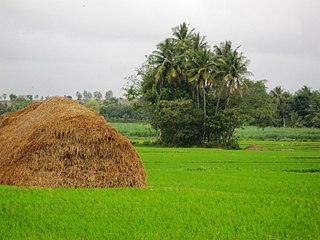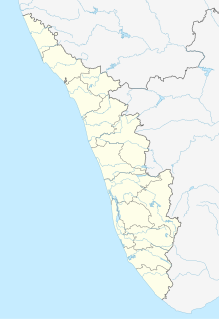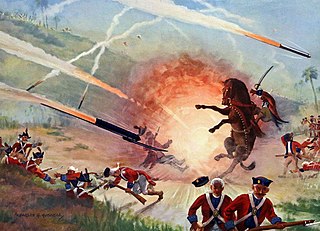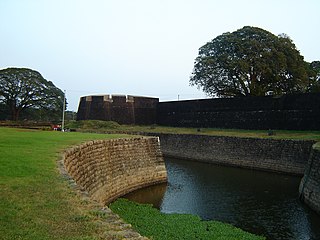
Srirangapatna is a town of Mandya district in the Indian State of Karnataka. Located near the city of Mysore, it is of religious, cultural and historic importance.

The Anglo–Mysore Wars were a series of wars fought in over the last three decades of the 18th century between the Kingdom of Mysore on the one hand, and the British East India Company, and Maratha Confederacy and the Nizam of Hyderabad on the other. Hyder Ali and his successor Tipu Sultan fought a war on four fronts with the British attacking from the west, south and east, while the Marathas and the Nizam's forces attacked from the north. The fourth war resulted in the overthrow of the house of Hyder Ali and Tipu, and the dismantlement of Mysore to the benefit of the East India Company, which won and took control of much of India.

The Fourth Anglo–Mysore War was a conflict in South India between the Kingdom of Mysore against the British East India Company and the Hyderabad Deccan in 1798–99.

Tipu's Tiger or Tippu's Tiger is an eighteenth-century automaton or mechanical toy created for Tipu Sultan, the ruler of the Kingdom of Mysore in India. The carved and painted wood casing represents a tiger savaging a near life-size European man. Mechanisms inside the tiger and man's bodies make one hand of the man move, emit a wailing sound from his mouth and grunts from the tiger. In addition a flap on the side of the tiger folds down to reveal the keyboard of a small pipe organ with 18 notes.

The Siege of Seringapatam was the final confrontation of the Fourth Anglo-Mysore War between the British East India Company and the Kingdom of Mysore. The British, with the allied Nizam of Hyderabad and Maratha, achieved a decisive victory after breaching the walls of the fortress at Seringapatam and storming the citadel. Tipu Sultan, Mysore's ruler, was killed in the action. The British restored the Wodeyar dynasty to the throne after the victory, but retained indirect control of the kingdom. The leader of the British troops was Major General David Baird.

The Tipu Sultan Shahi Mosque is a famous mosque in Kolkata, India. Located at 185 Dhartamtalla Street, the mosque is a relic of architectural and cultural heritage. Unlike usual Islamic culture, people from all sections of society and religions are obliged to visit and take pictures of this historical premises.

Thengana is a town in the Kottayam district of Kerala state in India. It belongs to Madappally panchayath and is 5 Kilometers away from Changanassery. The actual name of the place is 'Thenganaal' (തെങ്ങനാല്), but the revenue and Panachayath authorities have now accepted the colloquial form to the chagrin of local historians.

Fathul Mujahidin is a military manual that was written by Zainul Abedin Shustari at the instruction of Tipu Sultan, a de facto ruler of the Kingdom of Mysore, considered a pioneer in the use of rocket artillery. Mysore started to equip their army with rockets in the 1750s and during the Second Anglo–Mysore War (1780–1784) Tipu and his father Haider Ali used this technology against British troops. Tipu Sultan used rockets in battle with the British Army in the 1792 Siege of Srirangapatna, a battle at the end of the Third Anglo-Mysore War.

Devanahalli Fort is located 35 kilometers (22 mi) north of Bangalore city, at Devanahalli in the State of Karnataka, India. Chieftain Malla Byre Gowda of Avathi, a Vijayanagara empirevassal, built a mud fort in c. 1501 at Devanadoddi. In the late 18th century, Hyder Ali re-constructed the fort in stone resulting in the current structure.

Tipu Sultan's Summer Palace, in Bangalore, India, is an example of Indo-Islamic architecture and was the summer residence of the Mysorean ruler Tipu Sultan. Hyder Ali commenced its construction within the walls of the Bangalore Fort, and it was completed during the reign of Tipu Sultan in 1791. After Tipu Sultan's death in the Fourth Anglo-Mysore War, the British Administration used the palace for its secretariat before moving to Attara Kacheri in 1868. Today the government of Karnataka maintains the palace, which is located at the center of Old Bangalore near the Kalasipalyam bus stand, as a tourist spot.

The Battle of the Nedumkotta took place on 28 December 1789, and was a reason for the opening of hostilities in the Third Anglo-Mysore War. Forces of Tipu Sultan, the ruler of the Kingdom of Mysore, attacked the fortified line known as the Nedumkotta in Thrissur district that protected the Kingdom of Travancore. Travancore successfully defended their kingdom and defeated Mysore.
The Maratha–Mysore Wars was a conflict in the 18th century India, between the Maratha Empire and the Kingdom of Mysore.

The Mysorean invasion of Kerala was the military invasion of northern Malabar(now Kerala), including the territories of the Zamorin of Calicut, by the Muslim de facto ruler of the Kingdom of Mysore Hyder Ali. After completing the occupation, Kingdom of Cochin, situated south of Malabar, was made a tributary state of Mysore. The major reason for the occupation of Malabar was the desire to have access to the Indian Ocean ports. The Mysore invasion provided the English East India Company more chances to tighten their grip on the ancient feudal principalities of Malabar and converting Travancore, over whom Mysore Sultans attacked after Cochin, to a mere protected ally
Mysorean rockets were an Indian military weapon which were the first iron-cased rockets successfully deployed for military use. The Mysorean army used the rockets effectively against the British East India Company during the 1780s and 1790s. Their conflicts with the company exposed the British to this technology, which was then used to advance European rocketry with the development of the Congreve rocket in 1805.
Pratap Simha is a Member of Parliament from the 17th Lok Sabha of India. He was also a member of 16th Lok Sabha of India.He was born in Sakleshpura, Hassana. He represents Mysore constituency of Karnataka and he is the President of Yuva Morcha Bharatiya Janata Party (BJP), Karnataka. He won the Mysore Lok Sabha seat in 2019 with a margin of 1.39 Lakh votes by defeating the Congress candidate. Also he is the only candidate in history of Mysore lok sabha constituency to secure more than 5 lakh votes in both 2014 and 2019 Lok Sabha elections.
The Siege of Bahadur Benda happened between the forces of Tipu Sultan of Mysore and the Maratha forces of Haripant. On 1 January 1787 the Marathas had taken up position between Gajendragad and Koppal. On 3 January, Tipu Sultan laid siege upon the fort of Bahadur Benda, which was occupied by the Marathas at that time. Haripant attempted to try to stop Tipu's advances, but was unable to do so. The Maratha forces capitulated on condition of their lives being saved. After conquering Bahadur Benda, Tipu continued his efforts against the Marathas and the Nizam. These hostilities would continue until 10 February. This was the final battle between the Maratha Empire and the Sultanate of Mysore.
The Siege of Adoni occurred between the forces of Tipu Sultan of the Kingdom of Mysore and the Maratha Empire allied with the Nizam of Hyderabad. Tipu Sultan surprised Haripant when he decided to advance for Adoni. A group of Maratha and Nizam forces moved towards Adoni to provide relief. On 20 May, Tipu Sultan had annihilated the peth of Adoni and had devastated and inflicted immense losses on Adoni's cavalry. On 29 June, Tipu took the fort by surprise and "without firing a shot."
The Battle of Savanur occurred between the forces of the Maratha Empire and the forces of the Kingdom of Mysore from September 1786 to October 1786. Maratha general, Haripant's army decided to move to Savanur due to growing illness and lack of resources amongst his Maratha troops. His army was pursued by the forces of Tipu Sultan, who made two attacks early in September on the Maratha camp, which proved to be indecisive. On 15 September 1786, Tipu's army encamped approximately 5 miles from Savanur. On 1 October 1786, Tipu's army divided into four columns and made a surprise attack on the Maratha position. The Marathas, however, were informed by their spies about Tipu's surprise attack and had evacuated their position. The Marathas moved to a height from which they attacked Tipu's forces with artillery. Tipu ordered his troops not to fire back to deceive the Marathas into thinking that he did not possess long range guns. He did this to lure the Marathas to make an offensive. The strategy had proven to be effective, and the Marathas advanced to the Mysore position. When the Marathas had come close enough, Tipu's army unleashed a strong barrage of heavy fire on them. Tipu's heavy firing on the Marathas continued for approximately 7 hours. The Marathas were forced to retreat and Tipu Sultan entered Savanur on 10 October 1786 with support from the inhabitants of the city.
Sahebzada Syed Mansoor Ali Tipu is a social worker and the national president of Tehrik-e-Khudadaad. Belonging to the family of the Tipu Sultan, former ruler of Mysore, he is one of the seventh descendants of Tipu Sultan. As a researcher, major part of his work is to keep the family legacy alive and provide factual information about the family history and Tipu Sultan. Mansoor regularly participates in political debates concerning Tipu’s image and work for the welfare of various communities. He also works for the communal and regional peace in the southern and western part of India in the states of Karnataka, TamilNadu, Maharashtra and Kerala. Syed Mansoor became a political figure when he demanded reservation for Muslim Marathas, joining Sambha Ji Forces













